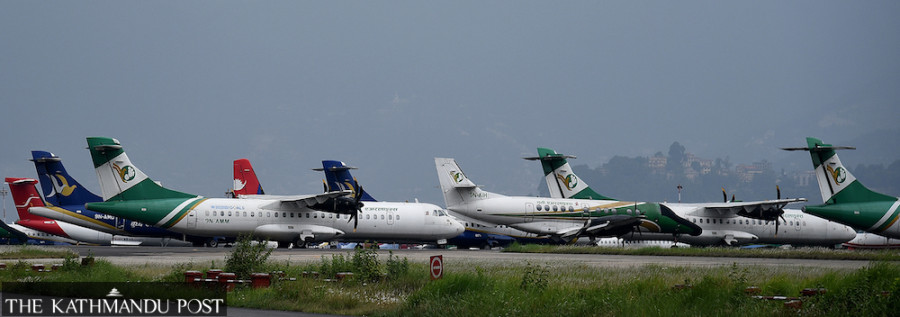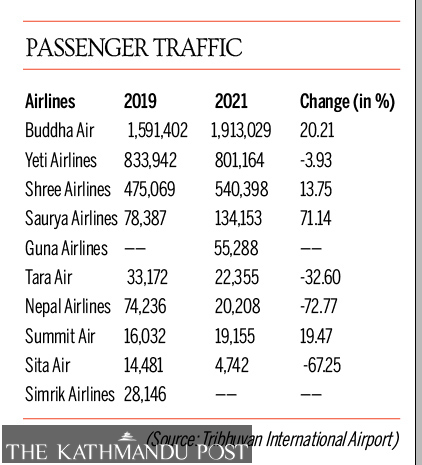Money
Domestic airlines carried record 3.54 million passengers in 2021
Cheap air tickets and Nepali travellers sick of bumpy roads contributed to the surge in air travel, insiders say.
Sangam Prasain
Nepalis are flying like never before and setting all-time high records in domestic passenger numbers, airport figures showed.
In 2021, a horde of 3.54 million domestic fliers braved Covid restrictions and took to the skies, the highest number of air travellers recorded in the history of Nepali aviation.
According to Tribhuvan International Airport statistics, domestic air passenger numbers were up a sharp 11.08 percent from pre-Covid 2019 levels, as airlines dangled cheap tickets to attract travellers.
There are 20 airline companies in Nepal, including 10 fixed-wing operators.
The statistics show that the popularity of plane travel took off in 2021 after a disastrous 2020.
Domestic passenger traffic at Kathmandu’s Tribhuvan International Airport had fallen to its lowest level in 2020 since 2009.
Domestic airlines carried 1.45 million passengers in 2020, a 54.28 percent plunge from the 2019 figure.
Aircraft movements also dropped to a multi-year low of 38,610 takeoffs and landings, representing a steep 57.94 percent fall from the year before.
When the pandemic started spreading, the government shut down all scheduled international and domestic flights from March 24, 2020. Airlines started flying again from September 21.
The year 2021 started with robust passenger demand despite health warnings that another Covid-19 surge could start soon.
At the end of April, infection caseloads rose and travellers were prevented from flying for two months. The government grounded all domestic flights in May when infection rates went haywire. The restriction was lifted in June-end following a drop in the caseload.
“Despite being grounded for two months, it was the airfare that prompted travellers to fly,” said Birendra Basnet, managing director of Buddha Air.
The airline industry experienced an unprecedented loss of billions of rupees in revenue in 2020. “Plane travel started lifting off again at the beginning of 2021, and picked up rapidly after the government started the vaccination drive,” said Basnet.
While most economic indicators in 2021 remained disappointing, domestic airlines, particularly, saw a phenomenal rebound. “It was indeed surprising,” said Basnet.
Deo Chandra Lal Karn, spokesperson for the Civil Aviation Authority of Nepal, sees five factors behind the jump in domestic air travel.
The first factor, according to him, is the price of a ticket that remains a crucial booster of passenger occupancy for domestic airlines. The second is road conditions, particularly during the monsoon season.
The third factor is that airlines now have bigger aircraft that can carry more people at a time. Most domestic airlines today fly planes with a capacity of more than 50 seats, as per Karna.
“The fourth factor is technology. Currently, there are flights operating even up to 11 pm, and chances of flight cancellations are rare,” said Karna. Seven airports in Nepal are equipped with technology to allow night flights.
Karna said that due to Covid, passengers preferred to take flights lasting from 30 minutes to an hour rather than travel for 7-8 hours by bumpy surface transport.
“Despite strong passenger growth, airlines are making very little money. The increase in passenger numbers has increased the cash flow in the industry, but most airlines are still in survival mode because of low revenue yields,” he said.
A breakdown of passenger numbers in 2021 shows that Buddha Air was the clear winner in passenger movement.
The carrier recorded a steep 20.21 percent growth in passenger numbers last year compared to 2019, flying 1.91 million passengers. Buddha Air, which currently has 15 aircraft in its fleet, grabbed 54 percent of the passenger market share.
“We are expecting to fly 3 million passengers in 2022,” said Basnet. “We are adding four 72-seater ATR-72 aircraft, three of which will arrive by April.”
Buddha Air plans to become a top ATR operator in South Asia within the next few years, and has been consolidating its plan accordingly.
Buddha’s closest rival, Yeti Airlines, saw its passenger numbers drop by 3.93 percent to 801,164 in 2021 compared to 2019.
Industry insiders say that Yeti Airlines is also planning to add two ATR-72 aircraft soon.
Nepal’s largest helicopter operator, Shree Airlines, which diversified into fixed-wing services in April 2017, flew 540,398 passengers, up 13.75 percent compared to the 2019 figure, to take the third spot in terms of passenger carriage last year.
Saurya Airlines, which started operations in November 2014, carried 134,153 passengers in 2021, up a steep 71.14 percent compared to the 2019 figure.
Guna Airlines, which made a comeback this year by buying five 30-seater Jetstream 31 aircraft from Yeti Airlines, carried 55,288 passengers in its first year of operation.
The year 2021 was a painful one for state-owned Nepal Airlines as it decided to ground all of its six Chinese-made planes in 2020 in a bid to cut losses. The national flag carrier flew 20,208 passengers in 2021, down 72.77 percent compared to the 2019 figure. It currently flies two Twin Otters.
Yeti subsidiary Tara Air, which only operates on remote sectors, also observed a sharp decline of 32.60 percent in passenger movement compared to the 2019 figure. It flew 22,355 passengers last year.
Summit Air, another airline serving remote destinations, saw passenger numbers jump by 19.47 percent to 19,155.
Sita Air flew 4,742 passengers, a 67.25 percent plunge compared to its 2019 performance.





 14.12°C Kathmandu
14.12°C Kathmandu















